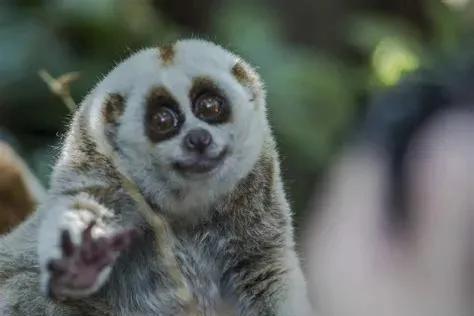The lorises are so named for their slow movements, also known as "bee monkeys" because of their honey-loving habits, and are taxonomically belonging to the loris family. There are 9 species in the family Lorises, mainly distributed in the subtropical forests of sub-Saharan Africa and South Asia.

Hello! Come and shake hands
Lorises are only distributed in Yunnan and southern Guangxi, and there are two species in China: lorises (bee monkeys) and small lorises (bonobo monkeys), all of which are national first-class protected animals. Of course, some scholars believe that there is also an intermediate type , the middle loris ( inter-bee monkey ) , based on two specimens collected before the 1980s , whose tooth features are different from the above two , but due to the lack of stronger evidence, it has not yet been widely recognized.
Hey! See what that is?
The appearance and size of the lorises and the small lorises are very similar, the body hair is short and dense, the coat color is light yellowish brown and dark brown, the head and limbs tend to be grayish white, the limbs are thick and short, and the face has two large eyes; the body length of the lorises is generally close to 30 cm or more, while the small lorises are usually less than 25 cm, a few centimeters. Therefore, it is difficult to distinguish by appearance alone, and one of the better features is the auricle: the auricle of the loris monkey is usually hidden in the hair bush, while the pinna of the small loris is more prominent and not covered by hair.
Get down and see if there's any fruit there!
The lorisprangi family is arboreal, nocturnal habits, spend almost all their lives in trees; afraid of strong light, sleeping on tree holes and trunks during the day, the movement is very slow, walking one step seems to stop two steps, only when attacked, it is accelerated; after dusk, it begins to actively forage, the food is mainly tropical fresh flowers and leaves and berries, but also preys on insects, good at preying on sleeping birds at night, like bird eggs and honey.
Not a single monkey came to play with me
The lorises are the only venomous animals among primates, with a venom gland at the elbow of the armpit. They will apply venom to their fur and teeth, which can avoid parasitism such as ticks and fleas and defend against danger, and the wound will be intensely painful after being bitten, and must be treated with antibiotics as soon as possible, otherwise, the wound will be infected and suppurated. Those who are too sensitive to venom can even develop fatal anaphylactic shock.
I'll see if there are any intruders
In the past, because of the weak awareness of law and protection, the capture and breeding of bee monkeys by the people has not stopped, and between 2010 and 2015, there were more than 30 incidents of private breeding of bee monkeys "fleeing" reported by online news, in more than 10 provinces in the north and south of the river.
Hurry up and let me out!
But fortunately, with the improvement of everyone's awareness and the strengthening of protection, Luchun and Yuanyang counties in southern Yunnan are one of the main areas for the distribution of bee monkeys, and there are also other primates such as Phyllis langurs, bear monkeys, macaques and rich biodiversity in the territory.